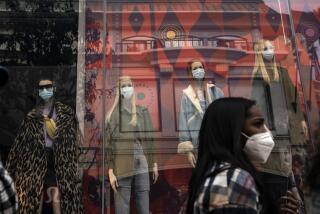We allowed coronavirus to ravage nursing homes. But there’s still time to save lives

- Share via
A lot of shocking data is coming out daily about COVID-19, but one statistic is particularly alarming. Recently, the Wall Street Journal reported that 4,800 nursing homes, nearly one in three in the whole country, have at least one COVID-19 infection. Even more frightening is that these data come from only 35 states, so the number could be substantially higher.
This scares us because nursing homes are the tinder in the wildfire. Even with underreporting, nursing homes account for more than one in five COVID-19 deaths in the U.S., and the true count could easily be twice as high. That’s the case in Massachusetts, where nursing homes account for 55% of all COVID-19 deaths, and in Europe, where the World Health Organization reported that half of COVID-19 deaths came from nursing homes. California reported last week that at least 40% of the COVID-19 deaths in the state have been in nursing facilities.
Nursing home residents are older, and have chronic illnesses, but their death toll is not mounting so quickly just because of this. It is happening because the U.S. does not make — and has never made — nursing homes a priority. There is still time to prevent the worst from happening. But to accomplish that, we need a national nursing home strategy for slowing COVID-19 today, and the center of that strategy must be a massive deployment of testing.
Regular testing with rapid results is key because as soon as any staff member or resident contracts COVID-19, nursing homes have to know immediately. Otherwise, widespread transmission is nearly inevitable. The nature of nursing homes means that there is close interaction between residents and staff on a daily basis. Social distancing makes it challenging to provide residents with the care they need, and nursing homes are struggling to maintain supplies of personal protective equipment to prevent infection.
The evidence of this challenge is that COVID-19 cases continue to rise in nursing homes, even though they’ve stopped accepting visitors, canceled all communal activities and largely stopped accepting new patients. For example, in New Jersey despite these steps, nearly every facility in the state has a documented COVID-19 case.
How can this happen? The secret weapon behind COVID-19 is that it spreads in the absence of any symptoms, even among older nursing home residents. In all likelihood, asymptomatic staff unknowingly brought these cases into the nursing homes.
This is why, if we don’t immediately begin universal testing of nursing home staff and residents immediately, COVID-19 will soon be in every nursing home in the country. By the time any staff member or resident develops symptoms, it is too late.
Several states have begun implementing universal testing of staff and residents. This is a step in the right direction, but we need federal leadership. The federal government should implement universal testing of all nursing home staff and residents. And this can’t be a one-off. We need a surveillance program that tests staff and residents at least weekly in order to identify new cases as they emerge.
In the absence of testing, nursing home staff are in a very fragile state. They have no idea what they are facing when they come to work each day. To complement testing, the federal government can take further steps to support nursing home staff struggling to keep themselves and their patients safe. This will be especially important as states begin to ease restrictions outside the nursing home and caregivers will likely begin having contact with more people when not at work.
The next-highest priority needs to be personal protective equipment like gowns, gloves and masks for all nursing home staff and training on how and when to use them. It is a national disgrace that staff are assisting residents with tasks like eating and using the bathroom without such protections. Staff shortages are also a key problem. They have long been an issue for nursing homes, but the problem has been magnified with staff getting coronavirus or otherwise being unable to work. Nursing homes need to receive higher reimbursement for coronavirus cases in order to prevent layoffs and maintain staffing levels. Staff also deserve a wage that is commensurate with the risks they are taking. And, in order to address staffing shortfalls that are inevitable when COVID-19 spreads in a facility, we need an immediate national effort to recruit people into this crucial field.
Nursing homes have been decimated by COVID-19. Policymakers and nursing homes have implemented some important steps to protect residents, but these steps will ultimately prove ineffective without frequent universal testing and increased support for direct caregivers. Every day we wait, we place frail residents and their caregivers at risk.
David C. Grabowski is a professor of healthcare policy at Harvard Medical School. Michael L. Barnett is an assistant professor of health policy and management at the Harvard T.H. Chan School of Public Health and a primary care physician at Brigham and Women’s Hospital.
More to Read
A cure for the common opinion
Get thought-provoking perspectives with our weekly newsletter.
You may occasionally receive promotional content from the Los Angeles Times.









